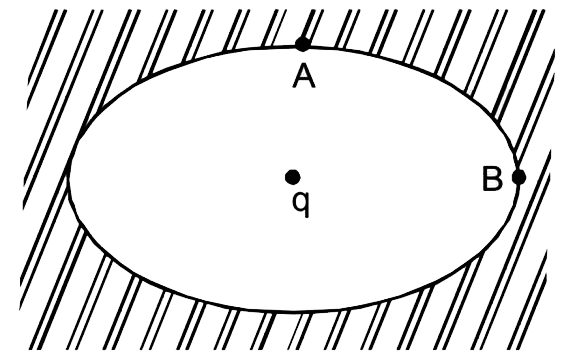A conductor A with a cavity as shown in is given a charge Q. show that the entire charge must appear on the outer surface of the conductor.

Another conductor B with charge q is inserted into the cavity keeping B insulated from A. Show that the total charge on the outside surface of A is Q+q
(c) A sensitive instrument is to be shielded from the strong electrostatic fields in its environment. Suggest a posible way.
We know that electric field →Einside a conducting shell is zero. Consider an imaginary Gaussion surface (shown by dotted curve in )
Around the cavity of the conductor A. As →E is zero total electric flus ϕ∈ over the Gaussian surface will be zero and it implies that no charges is
present within the Gaussian surface. It leads to the conclusion that entire charge given to the conductor must appear on the outer surface of conductor only.
(b) When a conductor B with charge q is inserted into the cavity of A, it induces a charges -q on the inner surface of conductor A and a charges +q is induced on the outer surface on conductor A. Consequently, total charge on the outer surface of conductor A becomes (Q+q).
(c) To shield a senstive instrument from strong electrostatic fields in its environment the instrument is placed inside a hollow conductor. Now irrespective of charge present on the conductor or any environmental electric field the electrostatic field in the cavity must be zero.
(##U_LIK_SP_PHY_XII_C01_E02_004_S01.png" width="80%">
Topper's Solved these Questions
- ELECTRIC CHARGES AND FIELDS BOOK - U-LIKE SERIESCHAPTER - ELECTRIC CHARGES AND FIELDS EXERCISE - CASE BASED/ SOURCE -BASED INTEGRATED QUESTIONS
14 Videos
- ELECTRIC CHARGES AND FIELDS BOOK - U-LIKE SERIESCHAPTER - ELECTRIC CHARGES AND FIELDS EXERCISE - MULTIPLE CHOICE QUESTIONS
30 Videos
- ELECTRIC CHARGES AND FIELDS BOOK - U-LIKE SERIESCHAPTER - ELECTRIC CHARGES AND FIELDS EXERCISE - SELF ASSESSMENT TEST (SECTION-B) (VERY SHORT ANSWER QUESTIONS)
4 Videos
- DUAL NATURE OF RADIATION AND MATTERBOOK - U-LIKE SERIESCHAPTER - DUAL NATURE OF RADIATION AND MATTEREXERCISE - SELF ASSESSMENT TEST SECTION-C (VERY SHORT ANSWER QUESTIONS)
3 Videos
- ELECTROMAGNETIC WAVESBOOK - U-LIKE SERIESCHAPTER - ELECTROMAGNETIC WAVESEXERCISE - SELF ASSESSMENT TEST (SECTION C)
1 Videos
Similar Questions
(a) A conductor A with a cavity as shown in Fig, is given a charge Q. Show that the entire charge must appear on the outer surface of the conductor.
(b) Another condutor B with charge q is inserted into the cavity keeping B insulated from A. Show that the total charge on the outside surface of A si (Q+q) fig.
(c) A sensitive instument is to be shielded from the strong electrostatic field in its enviroment. Suggest a possibe way.

View SolutionShow that the electric field at the surface of a charged conductor is proportional to the surface charge density.
View Solution
Knowledge Check
Work done in moving a charge q coulomb on the surface of given charged conductor of potential V is
AVq jouleBVq jouleCqV jouleDZeroThere is a conductor with cavity of radius R as shown in figure. A point charge Q is placed at R/2 distance from centre of cavity.
A point P is at r distance from centre of conductor. Then,
 Acharge density at iner surface of cavity will be non uniformBcharge density at surface of conductor will be uniformCelectric field at point P is Q4πε0r2Dforce on charge Q is non zero
Acharge density at iner surface of cavity will be non uniformBcharge density at surface of conductor will be uniformCelectric field at point P is Q4πε0r2Dforce on charge Q is non zeroAn ellipsoidal cavity is carved within a perfect conductor. A positive charge q is placed at the centre of the cavity. The points A and B are on the cavity surface as shown in the figure. Then
 Aelectric field near A in the cavity = electric field near B in the cavityBcharge density at A= charge density at BCpotential at A=potential at BDtotal electric field flux through the surface of the cavity is q/ε0
Aelectric field near A in the cavity = electric field near B in the cavityBcharge density at A= charge density at BCpotential at A=potential at BDtotal electric field flux through the surface of the cavity is q/ε0
Work done in moving a charge q coulomb on the surface of given charged conductor of potential V is
View SolutionLet at any instant point charge is at x distance from centre
Q. Net charge on surface of conductor at this instant
View SolutionA solid spherical conductor of radius R has a spherical cavity of radius at its centre. A charge is kept at the centre. The charge at the inner surface, outer surface are respectively.
View SolutionA charge q is uniformly distributed over the surface of a ring-shaped conductor of radius a. Find the field intensity on the axis of the conductor at a distance x from the plane of the conductor.
View SolutionA solid spherical conductor of radius R has a spherical cavity of radius a(a+Q is kept at the center.The charge at the inner surface outer and at a position r(a<r<R)are respectively.
View Solution
